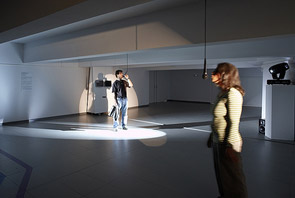

Image down: Laboratorio de Luz
Modulador de Luz 3.0 (Light Modulator 3.0), 2006/08
Laboratorio de luz
Interactive installation
A uniquely human characteristic is that all the functional apparatuses of a human can never be sated; they are always eager for new impressions after each new perception. This explains the permanent need to carry out new experiments.
Moholy-Nagy
In terms of kinetic relations of projected light, Light Modulator 3.0 (2008) explores possibilities in connection with various relations and behaviors between light and sound based on the sound actions carried out by users; the relations of light-space-time/reflections-shadow-movement used in Moholy-Nagy’s original Modulator are expanded now with the incorporation of sound, in search of new space-time relations which include the challenge of building a network of relations in an empty space.
 The installation is presented as an empty stage setting, waiting for speech. When someone speaks, the microphones attract theatrical lighting. However, the behavior of the lights in relation to speech, sound, and music leads to unexpected games, and various roles and attitudes taken by light. At times it is quick and intense, but at others, it is hesitant and shyly turns to this microphone or that. It is a social physics of actions and reactions where the illumination desired by all the spectators-actors is not always achieved.
The installation is presented as an empty stage setting, waiting for speech. When someone speaks, the microphones attract theatrical lighting. However, the behavior of the lights in relation to speech, sound, and music leads to unexpected games, and various roles and attitudes taken by light. At times it is quick and intense, but at others, it is hesitant and shyly turns to this microphone or that. It is a social physics of actions and reactions where the illumination desired by all the spectators-actors is not always achieved.
Between the microphones, which act as a sensor layer, and three spotlights robotized via DMX, there is specific software made in C++ -as a synapses layer- to generate a semi-autonomous interactive light environment where the movement of the light is given as a response or a starting layer. This network of relations is used as an audio patch for feedback, made in Max/MSP, to generate real-time sound based on entry data. There are fixed platforms and variable flows— points, nodes or agents that manage the structure of the relations. The Modulator, as a complex spatial machine, includes the visualization of the “possibilities” generated (potential events); like a valuation sphere, it retains the routes, registers what happened in graphic representations as a reciprocal agency between the system and any spectator-actor who, after a time, approaches to "find out more" about the mechanism.
Light machines, microphones, algorithms and microprocessors designate the specificity of a foreseeable, technical evolution, only altered by the interventions of spectators-actors through the microphones, who introduce into the Light Modulator 3.0 system a break in the machinelike routine based on connections or links (joining them all to each other, linear, predetermined...) that generate a "network", a praxis that generates heterogeneity; an imaginary network, always open in all directions, procedural in nature, that does not seek to evaluate a possible end (a competitive adaptation to the environment) as an image of uncontrolled technical development, given that Light Modulator 3.0 works, originally a system that, given the absence of intervention, could not avoid repetition, repose, or chaos.
